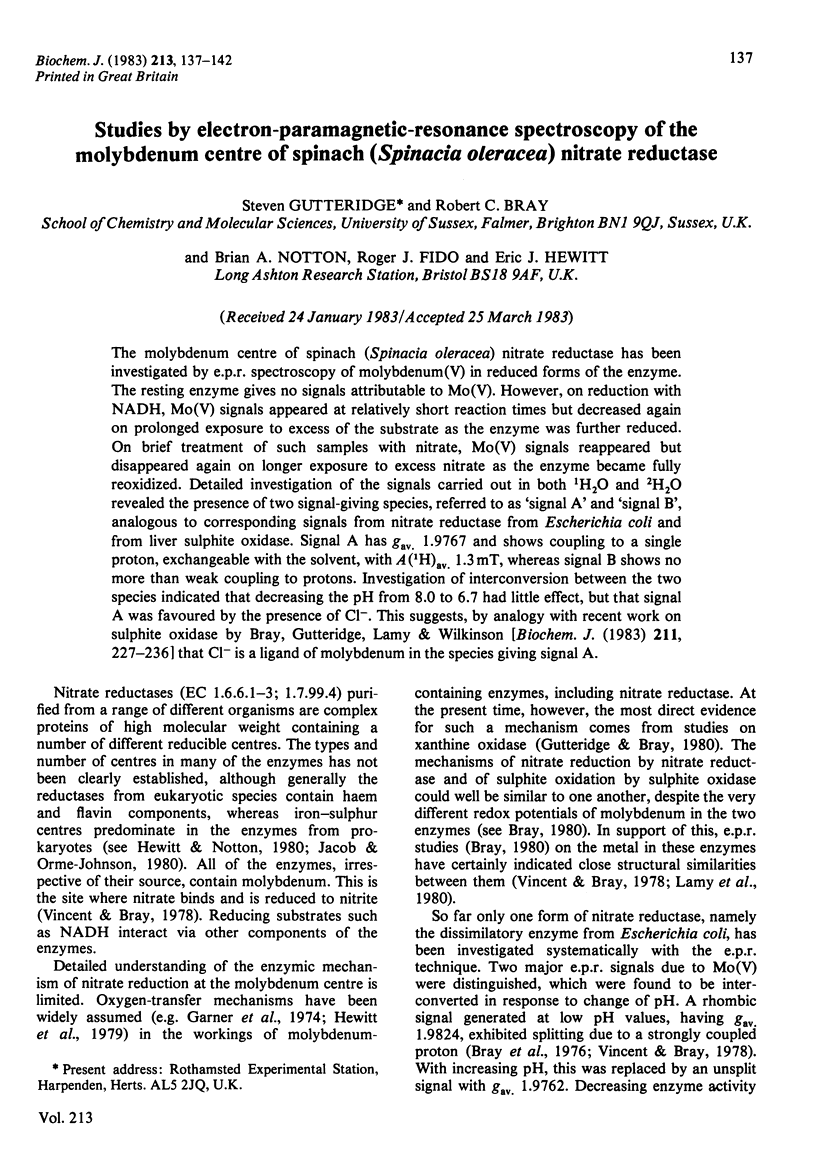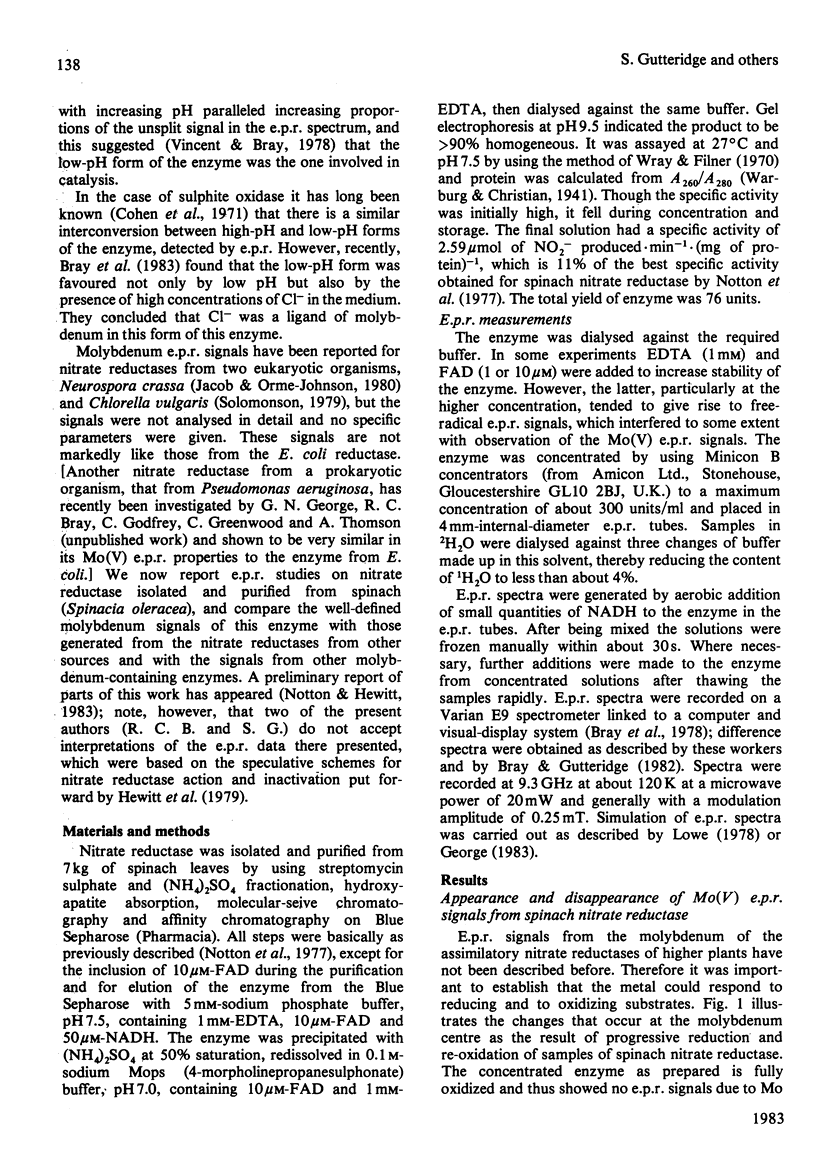Abstract
The molybdenum centre of spinach (Spinacia oleracea) nitrate reductase has been investigated by e.p.r. spectroscopy of molybdenum(V) in reduced forms of the enzyme. The resting enzyme gives no signals attributable to Mo(V). However, on reduction with NADH, Mo(V) signals appeared at relatively short reaction times but decreased again on prolonged exposure to excess of the substrate as the enzyme was further reduced. On brief treatment of such samples with nitrate, Mo(V) signals reappeared but disappeared again on longer exposure to excess nitrate as the enzyme became fully reoxidized. Detailed investigation of the signals carried out in both 1H2O and 2H2O revealed the presence of two signal-giving species, referred to as 'signal A' and 'signal B', analogous to corresponding signals from nitrate reductase from Escherichia coli and from liver sulphite oxidase. Signal A has gav. 1.9767 and shows coupling to a single proton, exchangeable with the solvent, with A(1H)av. 1.3mT, whereas signal B shows no more than weak coupling to protons. Investigation of interconversion between the two species indicated that decreasing the pH from 8.0 to 6.7 had little effect, but that signal A was favoured by the presence of Cl-. This suggests, by analogy with recent work on sulphite oxidase by Bray, Gutteridge, Lamy & Wilkinson [Biochem. J. (1983) 211, 227-236] that Cl- is a ligand of molybdenum in the species giving signal A.
Full text
PDF





Selected References
These references are in PubMed. This may not be the complete list of references from this article.
- Bray R. C., Barber M. J., Lowe D. J. Electron-paramagnetic-resonance spectroscopy of complexes of xanthine oxidase with xanthine and uric acid. Biochem J. 1978 Jun 1;171(3):653–658. doi: 10.1042/bj1710653. [DOI] [PMC free article] [PubMed] [Google Scholar]
- Bray R. C., Gutteridge S., Lamy M. T., Wilkinson T. Equilibria amongst different molybdenum (V)-containing species from sulphite oxidase. Evidence for a halide ligand of molybdenum in the low-pH species. Biochem J. 1983 Apr 1;211(1):227–236. doi: 10.1042/bj2110227. [DOI] [PMC free article] [PubMed] [Google Scholar]
- Bray R. C., Gutteridge S. Numbers and exchangeability with water of oxygen-17 atoms coupled to molybdenum (V) in different reduced forms of xanthine oxidase. Biochemistry. 1982 Nov 9;21(23):5992–5999. doi: 10.1021/bi00266a041. [DOI] [PubMed] [Google Scholar]
- Bray R. C. The reactions and the structures of molybdenum centers in enzymes. Adv Enzymol Relat Areas Mol Biol. 1980;51:107–165. doi: 10.1002/9780470122969.ch3. [DOI] [PubMed] [Google Scholar]
- Bray R. C., Vincent S. P., Lowe D. J., Clegg R. A., Garland P. B. Electron-paramagnetic-resonance studies on the molybdenum of nitrate reductase from Escherichia coli K12. Biochem J. 1976 Apr 1;155(1):201–203. doi: 10.1042/bj1550201. [DOI] [PMC free article] [PubMed] [Google Scholar]
- Cohen H. J., Fridovich I., Rajagopalan K. V. Hepatic sulfite oxidase. A functional role for molybdenum. J Biol Chem. 1971 Jan 25;246(2):374–382. [PubMed] [Google Scholar]
- Garner C. D., Hyde M. R., Mabbs F. E., Routledge V. I. Possible model reactions for the nitrate reductases. Nature. 1974 Dec 13;252(5484):579–580. doi: 10.1038/252579a0. [DOI] [PubMed] [Google Scholar]
- George G. N., Bray R. C. Reaction of arsenite ions with the molybdenum center of milk xanthine oxidase. Biochemistry. 1983 Mar 1;22(5):1013–1021. doi: 10.1021/bi00274a003. [DOI] [PubMed] [Google Scholar]
- Gutteridge S., Bray R. C. Oxygen-17 splitting of the very rapid molybdenum(V) e.p.r. signal from xanthine oxidase. Rate of exchange with water of the coupled oxygen atom. Biochem J. 1980 Sep 1;189(3):615–623. doi: 10.1042/bj1890615. [DOI] [PMC free article] [PubMed] [Google Scholar]
- Gutteridge S., Tanner S. J., Bray R. C. Comparison of the molybdenum centres of native and desulpho xanthine oxidase. The nature of the cyanide-labile sulphur atom and the nature of the proton-accepting group. Biochem J. 1978 Dec 1;175(3):887–897. doi: 10.1042/bj1750887. [DOI] [PMC free article] [PubMed] [Google Scholar]
- Hewitt E. J., Notton B. A., Garner C. D. Nitrate reductases: properties and possible mechanism. Biochem Soc Trans. 1979 Aug;7(4):629–633. doi: 10.1042/bst0070629. [DOI] [PubMed] [Google Scholar]
- Lamy M. T., Gutteridge S., Bary R. C. Electron-paramagnetic-resonance parameters of molybdenum(V) in sulphite oxidase from chicken liver. Biochem J. 1980 Feb 1;185(2):397–403. doi: 10.1042/bj1850397. [DOI] [PMC free article] [PubMed] [Google Scholar]
- Lowe D. J. Electron paramagnetic resonance in biochemistry. Computer simulation of spectra from frozen aqueous samples. Biochem J. 1978 Jun 1;171(3):649–651. doi: 10.1042/bj1710649. [DOI] [PMC free article] [PubMed] [Google Scholar]
- Malthouse J. P., Gutteridge S., Bray R. C. Rapid type 2 molybdenum(V) electron-paramagnetic resonance signals from xanthine oxidase and the structure of the active centre of the enzyme. Biochem J. 1980 Mar 1;185(3):767–770. doi: 10.1042/bj1850767. [DOI] [PMC free article] [PubMed] [Google Scholar]
- Vincent S. P., Bray R. C. Electron-paramagnetic-resonance studies on nitrate reductase from Escherichia coli K12. Biochem J. 1978 Jun 1;171(3):639–647. doi: 10.1042/bj1710639. [DOI] [PMC free article] [PubMed] [Google Scholar]
- Wray J. L., Filner P. Structural and functional relationships of enzyme activities induced by nitrate in barley. Biochem J. 1970 Oct;119(4):715–725. doi: 10.1042/bj1190715. [DOI] [PMC free article] [PubMed] [Google Scholar]


